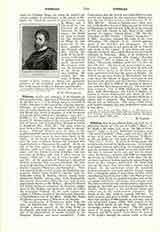

Tiberias, SEA OF, so called in John, xxi, 1 (cf. vi, 1), otherwise known as “the sea of Galilee” (Matt., iv, 18; Mark, i, 16; John, vi, 1), or as “the lake of Genesareth” (Luke, v, 1, and Rabbinical writings), or as “the sea of Cenereth” (Num., xxxiv, 11; Jos., 27; cf. Jos., xi, 2), or as “the water of Genesar” (I Mach., xi, 67), or, lastly, as “the Lake of Tarichea” (Pliny, “Hist. Nat.”, V, xv) . It lies in the Jordan gorge, 682 feet below the level of the Mediterranean. An irregular oval nearly thirteen miles long, its maximum width, near the northern end, is about seven and a half miles. The lake is enclosed on the east and west by mountains; the former, a uniform wall 2000 feet high sloping steeply to within half a mile of the shore; the latter, lower and more broken, gradually approaching the water as they advance northwards till, about half way up the coast, they leave only a narrow strip of littoral. At the northwest corner the mountain inclines somewhat westward and the littoral widens into a triangular plain of marvellous fertility which stretches eastwards for four miles—the Plain of Genesareth. East of this the ground is broken and sterile, overgrown with bush, and strewn with volcanic rock. The lake is fed by several torrents and by copious hot springs on the north and west, but principally by the Jordan, which enters at the northeast corner and rushes out at the southwestern extremity. The depth of the lake nowhere exceeds 150 feet. Its water is sweet and good to drink. Fish are so abundant that catches of 600 pounds are not rare, and in one exceptional season (1896) 9200 pounds of fish were hauled ashore in one huge net. Storms are alarmingly sudden and frequent. The hot atmosphere of the gorge (averaging in the shade 93°F. in summer, and 50° in winter) sucks down the cool air of the heights through the narrow wadis to the east and west at the north end, and in half an hour the surface of the lake tosses furiously. Half an hour again suffices to restore the lake to a mirror-like calm.
Today the shores are barren and desolate, with gloomy patches of volcanic soil to the north and west. There is scarcely a tree to be seen, nor even any verdure except where an overflowing torrent waters the northwestern plain, nor any human habitation save the sombre houses of Tiberias to the west and a few straggling villages. But in the days of Christ nature and man united to render these shores singularly attractive. The vine and the fig flourished ten months in the year, and every variety of fruit ripened in the various seasons: thick woods surrounded the lake even down to the eighth century of the present era, and the plains yielded rich harvests twice in the year. Nine, perhaps ten, cities encircled the lake with an almost unbroken front of wharves and harbors. Ruins of theatres, hippodromes, temples, synagogues, baths, and villas witness to the presence of all the refinements of Graeco-Roman culture. Fishing was an important industry (cf. Beth Saida= “Fishing-House”, and Tarichece=”Pickling Factories”), and the fishermen, though reputed generally pious by the Rabbis, were a force to be reckoned with in troubled times. The fish were exported to all parts of the Roman world. The standing population of the towns, of which the smallest had at least 15,000 inhabitants, was largely increased by multitudes of sick who flocked, especially in summer, to the world-renowned springs near Tiberias.
JEREMIAH HARTIGAN

